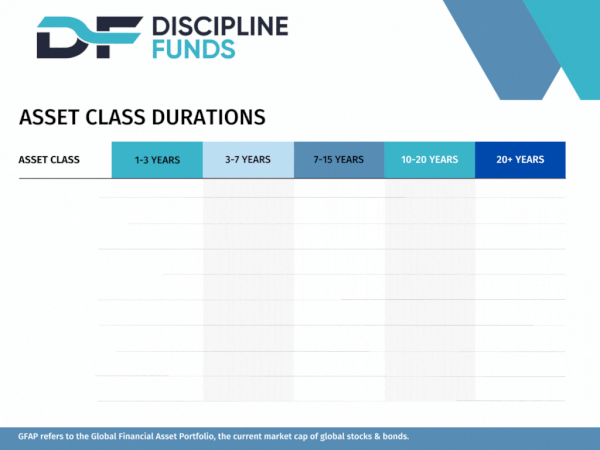
We’ve been implementing the Defined Duration strategy in real-time for over a year now and the feedback has been tremendously positive (updated white paper is here).
For those who aren’t familiar, this strategy is based on the asset-liability matching methodology model we constructed which quantifies a “duration” for all asset classes and strategies. This allows us to build a portfolio that is very similar to a bond ladder in that it structures your allocation across time. The difference between this and a bond ladder is that we can add all asset classes into the methodology. This is especially helpful for financial planning because it allows us to quantify someone’s liabilities and then match the right assets to those liabilities. It’s similar to what insurance companies, banks and large pensions do to manage their asset-liability mismatches.1 But the Defined Duration approach brings this to retail investors in a low cost and accessible manner.
How Does it Work?
Traditional asset managers build portfolios by trying to optimize portfolios for risk adjusted returns and typically charge high fees in the process. We know this process doesn’t work well because we know that 80%+ of all active managers underperform the market. We also argue in the paper that this process creates conflicts of interest because the primary way investment managers “beat the market” is by taking more risk. But taking more risk means you’re creating more upside variance AND more downside variance. This exacerbates behavioral risks as you feel good on the way up and then you’re terrified on the way down (and you risk abandoning the plan). The problem here is that the asset manager is only looking at the asset side of the equation with total disregard for the client’s liability needs. But it’s the liability needs that make us all worried – we worry about our asset values because we can see and feel the quantity of expenses and liabilities we have over time.
The Defined Duration approach flips all of this around. Instead of selling a high fee “beat the market” portfolio that focuses on the asset side of the equation, the Defined Duration process starts first with a personalized financial plan that focuses on the client’s liabilities. Once we quantify someone’s liabilities then we match the right assets structured over time (and accounts) to give the investor greater confidence over the quantity of assets they’ll have at specific times in life.
The best part is, it’s low fee, tax efficient, diversified and we would argue, much more behaviorally robust than your standard portfolio construction process.
We hope you enjoy the paper and as always, feel free to reach out with any questions or comments.
Defined Duration Investing White Paper
1 – This is especially interesting in the case of the recent banking panic where banks were caught with their pants down because they had too much exposure to long duration assets and became forced sellers. They had an asset-liability mismatch. This is essentially what happens to many investors when they panic sell into downturns. They have an asset-liability mismatch that scares them and while they probably don’t think of it in those terms they know it intuitively and therefore desire more short-term certainty. The Defined Duration strategy helps put this into better context so you better understand how your assets match your liabilities thereby helping you reduce behavioral mistakes and maintain a more sustainable financial plan.
